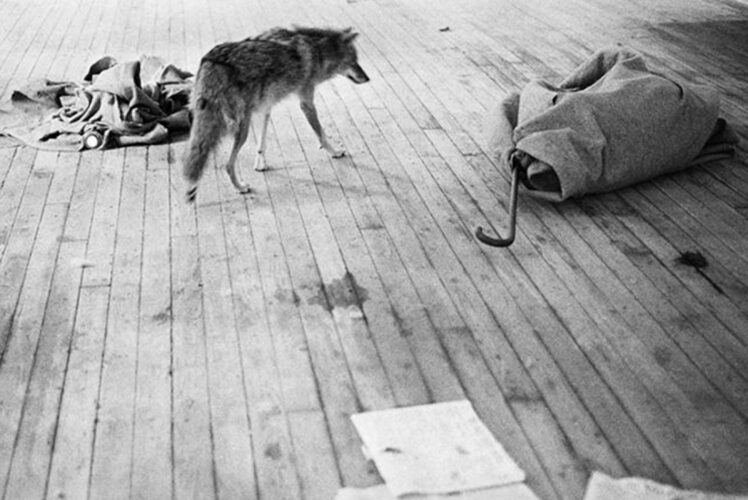
Beuys’ role from the perspective of art history
Joseph Beuys was the most influential artist in the second half of the 20th century. Although he gained international fame in the 1970s, his utopian projects in the field of fine art are rather unknown or received with a wry smile by the general public. Beuys proposed a very broad interpretation of art that went beyond the artistic tradition of his time, an interpretation with which he surprised his contemporaries. Beuys expanded the interpretation of the notion of art. He supported the idea of interaction between art and the outside world. The artistic revolutions that took place in the first half of the 20th century practically brought about a radical change in the inner world of art. Beuys’s work can be a representative example of the neo-avant-garde of the 60s/70s. His artistic spirit and practice were determined by the idea of radically changing art paradigms and social contexts. In this sense, he resembles the avant-garde artists of the early 20th century, but his visions are not motivated by cosmic or metaphysical concepts of art, rather by reactions arising from the awareness of the globalization of the world. As he himself calls them, his visions are “concrete utopias”. At the same time, his activity anticipated the changes in the artistic world of the 1980s, and the beginning of a new postmodern period, whose spirit is no longer characterized by radical social changes.
Beuys’ visual and verbal pictorial forms
Beuys’ artistic legacy is not only made up of his drawings, objects or actions, but also his verbal statements which were made during his public performances on the occasion of his public appearances, in relation to the exhibited works and actions. The organic unity of these two aspects is an important characteristic of Beuys’ artistic spirit and practice.
He considered that not only his works of art are pictorial, but also “thought and conversation can be considered ’pictorial figures’, formed according to principles similar to his artistic creations”, writes Tibor Várnagy in the preface of one of the books about Beuys published in Hungarian[1]. In the case of Beuys, the drawings serve to represent the thought process and appear as diagrams of visual ideas for our eyes and brains. This procedure is best seen in his blackboard drawings, which were made as visual supplements to his lectures.

Beuys’ verbal statements are not conceptual theories, theorems or manifestos. “He never wrote a book about the theory of his art, he never tried to create a closed theoretical system about his artistic concepts, about the extended notion of his art or about his social endeavors…”, writes Tibor Várnagy in the preface of the aforementioned book up. Beuys believed that spoken language and verbal explanation were indispensable. For him, conceptual explanations and images are complementary in his blackboard drawings – these were visual supplements to his lectures.
His verbal statements were primarily meant to illuminate the purpose of his art projects, or served to better understand his works. His theoretical statements refer to his own work, his artistic perception and his concrete projects, which also shed light on the theoretical side of his artistic thinking.
According to Beuys, “the visual artist does not only work with physical materials” but “must also glimpse ideas!” and moreover, there is a need for the “figuration of thought”. In this sense, the theme of his drawings is the representation of artistic ideas (quotes from the aforementioned book). During a podium discussion, the audience asked Beuys: “Is your art understandable only to those who understand its theoretical content?” Beuys denied this. His view becomes even clearer as a result of his response during this discussion. I quote Beuys’ statement from one of Matthias Bunge’s[2] writings:
“No, (…), because then I would be committing a ‘completely stupid mistake’: (…) because then, the idea (concept) behind the works would be the work itself, and then, why should I realize these formations, which you, yourself should perceive with your own senses. Otherwise, I could describe these with logical statements. (…) I argue (…), that these theoretical contents can be discovered in these physical phenomena by looking closely at them, if you discover the structures of environments and actions. (…) In fact, I argue that these physical phenomena become much more intense if we perceive them without the crutches of theory. This should not lead to the misunderstanding that I have fabricated a theory to provide an explanation for a particular work, sculpture or medium. (…) Art requires the ability to imagine”.
Beuys distances himself from this type of conceptualist approach that radically eliminates visual art materials and limits himself to the use of “verbal concepts” in exhibitions. It is known that the materials and linguistic tools of classical conceptual art are concepts and texts, with which it aims to communicate a thought, an idea or a concept. [3] Conceptual art, in its radical form, does not aim to establish a referential relationship with sensual “reality”, be it visible, tangible, etc., except on a conceptual level. Although Beuys is indeed interested in the artistic language, the concept of art and the various contextual problems of art, for him his objects, mediums and actions are physical phenomena in which the problematics of the content is shaped into a perceptible pictorial form. Beuys’ drawings possess sensual qualities due to the use of specific materials and tools.
An interesting intermediate zone is his blackboard drawings, which, according to Beuys, are pictorial forms of how visual thought and ideas come to be. He makes a clear statement about the role of art in another video interview: “…art must train and develop the human sensory system. Without this, without an educational activity through art, the human sensory system will die and only pure intellectual, logical, abstract thinking that functions in technological progression will remain.”[4]
According to Beuys, any material can be used to create a work of art (medium as portable material of the artistic message), not just the accepted materials of traditional art practice. Thus, in addition to traditional materials (bronze, iron, wood, paper, etc.), he also uses unconventional materials (fat, felt, honey, beeswax, sulphurous gas, chocolate, iodine, lemon, lead, etc.) .
Beuys’s materials and objects are symbolic carriers of his own visions, which are always associated with magical meanings. For example, fat appears as a source of heat energy, a material that indirectly refers to the heat energy of love, and felt is a material that insulates energy, indirectly referring to the protection of life energy. Copper is a conductive metal with good energy, which, in this sense, appears several times in Beuys’ energy-themed installations. Installations such as Sealed Letter (1967), Felt Suit (1970), Sleigh (1969) or Homogenous infiltration for grand piano (1966) show the symbolic use of felt. These works are felt objects and installations but, in other cases, the felt objects and other materials are props for his performances and presentations.
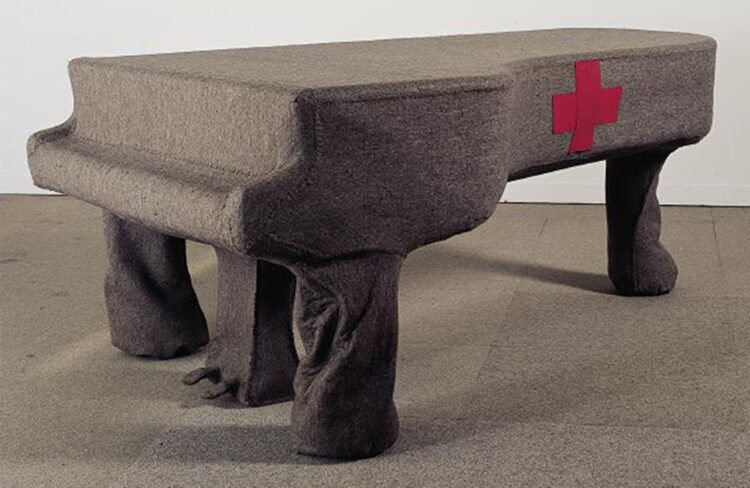
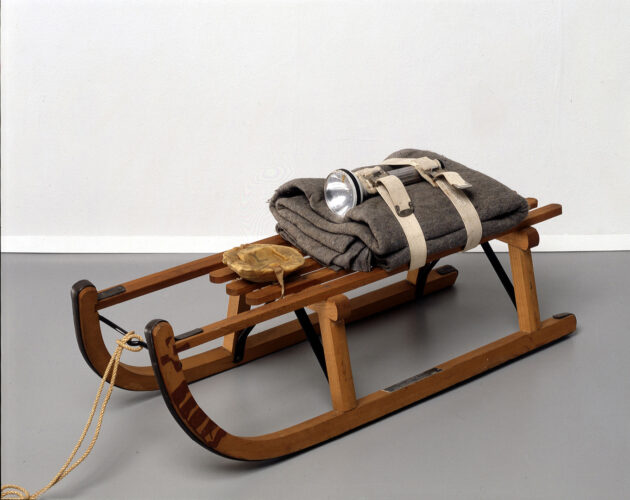
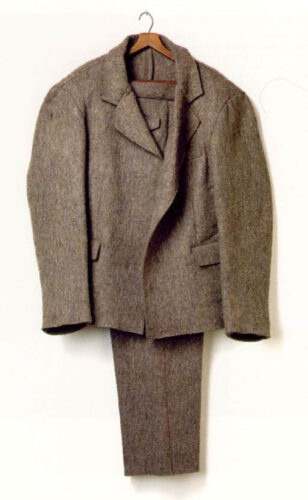
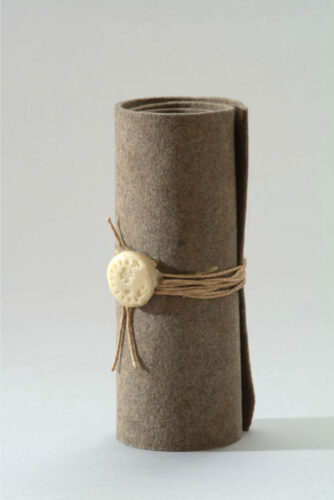
Social sculpture – expanding the notion of art
The idea of Social Sculpture proposed by Beuys would mean that art should be involved in a special way in the fields of society, same as work, education, legal practice, science, environmental protection, politics and economic life. In the sense of this idea, he proposes a broader interpretation of art.
Joseph Beuys’ action Honeypump at the Workplace (1977) best represents the vision of the Social Sculpture. This action was one of the highlights of the 6th Documenta contemporary art event in Kassel (1977). The two elements in the title indicate the two components of Beuys’ work. On the one hand, the Honey Pump is a grandiose technical installation installed in the engine room, which was located on the lower level of the building, with a network of pipes and cables attached to it; on the other hand, the Workplace, which refers to the workers in the neighboring museum location. They are the intellectual workers for art and exhibitions. The technical installation extended its pipe network horizontally and vertically in certain areas of the building. In Beuys’ view, the artist’s work is organically linked to the social work of art professionals.
On the occasion of Documenta in Kassel, Beuys also formulated that the development of art is not possible. A structure is needed for the future. Therefore, it is necessary to develop a concept for culture and art that is more comprehensive than the current one. This should include not only the arts, but education, media and IT as well.
Honey is flowing in all directions reveals another aspect of the artistic phenomenon. Today, the piece has a become a museum relic, where only traces of its original action and installation can be detected or perceived. We miss seeing the work as it actually functioned back then, with the honey pump working, the cables and pipe system intertwining around the enclosure, the transparent pipes in which the pulsating honey flowed, with its puffs and air bubbles, with the smell of the material processes. The museum version also lacks the physical architectural framework of the installation and the artistic context of the 1977 edition of Documenta in Kassel, and many other things… and, last but not least, the living personality of Beuys, who prepared his blackboard drawing diagrams every day for that day’s seminar.
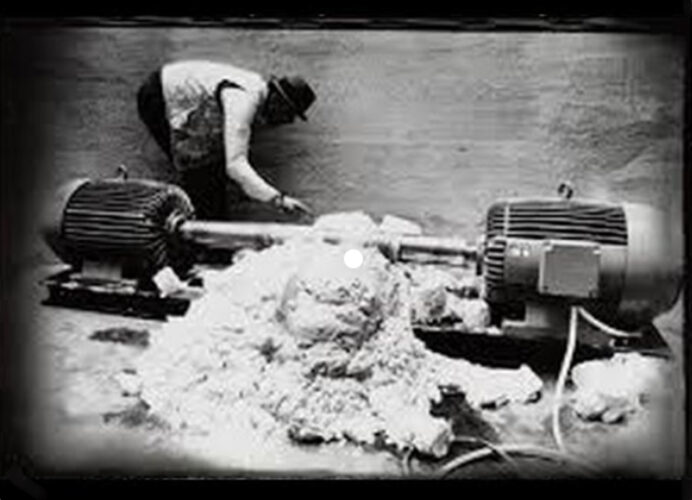
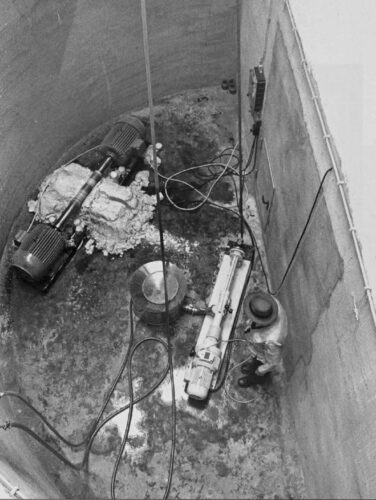
The message behind Social Sculpture, forwarded by Beuys, is that art can be linked to areas of society such as work, education, legal practice, science, environmental protection, politics and economic life. It proposes a broader interpretation of art. Art should be sensitive to the problems that plague the world, to the crises caused by economic-social-political and cultural changes and to the global ecological disasters of our times. According to Beuys, art education should not only develop image and design skills, but also teach people how to shape their environment and world.
According to him, art can be extended to anything, and creativity is everyone’s right. We tend to interpret Beuys’s projects pragmatically, even though they are utopian artistic projects that were born to stimulate our relational thinking. Beuys is not a politician, but an artist. In the 1960s, he was already sensitive to those changes, which have become much more evident today in our globalized world. After half a century has passed, we have become somewhat accustomed to his visions. Today, we can better understand the phenomena of the global world thanks to his projects, such as the Energy Plan for Western Man, Eurasia or I Love America and America Loves Me.
Through his lectures, media appearances and actions, Beuys advocated a revision of the Western world’s energy plan. The Energy Plan for the Western Man project arose from his conviction that man can shape a new vision of the world as a spiritual being and place the evolution of the Western world on new principles. According to Beuys, the principle of spirituality in the Western world has been damaged. Although it has global ambitions, this spirituality’s regenerative impulses can be compromised if it isolates itself from its natural sources. It is less and less able to communicate with other types of cultures and life forms because its language of communication is determined by an institutional framework based on selfish individualism and the pursuit of profit.
Beuys draws attention to the fact that the production of material goods is not only a matter of economic development, but also depends on the level of consciousness development. Moreover, this development is important in the first place, because this is how the above-mentioned crisis can be overcome. Through his projects, Beuys also designates the details of development. Beuys’ drawings, installations and actions evoke traces of ancient cultures and nomadic ways of life. These confront certain expectations of Western civilization in specific visions. One such metaphorical motif is the “Eurasian cane”. This appears as a spiritual vein, which led the former migrants to the vast, still ununified territories of Eurasia, and which left a trace, not just a besieged residual soil – according to his vision.
Art critic Caroline Tisdall, a contemporary of Beuys, followed his actions throughout his career. She writes the following about Beuys’s work in 1974: “The search for European and Eurasian intersections of energy and trauma is a constantly recurring theme in Beuys’s work.” [5] In the 1960s, the theory of Eurasia did not seem so important to the public, who did not realize how closely the energies and traumas of Eurasia were connected to each other, and that these two elements were going through different stages of transformation at the same time.
Because of our pragmatic worldview, we are perplexed by projects and ideas such as the one promoted by the Political Party for Animals project. This project is not a development plan for an animal protection association, but is part of the energy project mentioned above. According to Beuys, animals – and generally the so-called lower species and forms of life – can represent invisible resources for humans. Animals have abilities that Western man today no longer possesses, he has lost his ability to adapt and the perception of lower forms, he is not inclined to observe those perspectives of development, which can be derived from the group forms of animal existence.
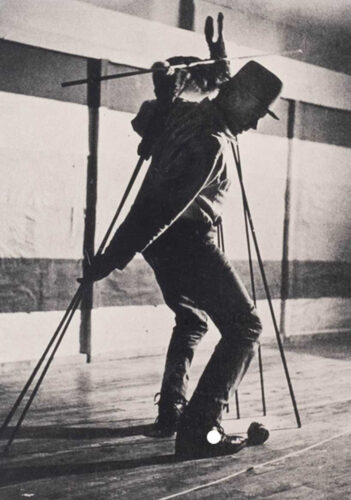

We know that Beuys has expressed his interest in ecology. He drew the public’s attention to the world’s ecological disasters in several public actions and appearances. He emphasized the consequences of these ecological disasters in the context of a global world. But he was not an environmental activist, he did not want to plant 7,000 trees on the occasion of the 7th edition of Documenta to pragmatically develop the green area of the city, rather he wanted to make those involved in planting aware of the importance of environmental protection. [6] This is underlined by Beuys’s statement: “Trees are not essential for the survival of life on earth. No, trees are important to save the human soul. I am not interested in the ecology of the spinach. The world can cease to exist. Earth could be destroyed. But if earth is destroyed in the state in which it is now, then the human soul is in danger. The only thing worth saving is the human soul. I understand the word ’soul’ more like a synthesis of things. It includes not just emotionality, but recognition, self-awareness and will as well. These are things that are often damaged today (…) Without these thoughts, it makes no sense to cultivate the best quality potatoes.”
Beuys was not interested in pragmatic politics. Perhaps that is why he cut ties with the environmental activists who founded the Green Party after they merged into a political party. Beuys was a supporter of Voters Without Ideology and the Free Voters organization.
Many people have misunderstood Beuys’ statement that “every man is an artist”. In this sense, he says, I quote: “The expression ‘everyone is an artist’ means that man is a creative being, capable of creatively producing in many different ways. In principle, it doesn’t matter to me whether the product comes from a painter or sculptor, or from a physicist.” He adds, “For the world to change, creativity and spirit must first be set free.” So, not just the spirit of the visual artist, but also that of the baker, cobbler or anyone who creates. That their spirit may not be bound when they shall have the opportunity to take up art, if circumstances permit.
Coyote action in a neo-avantgarde and post-modern interpretation
Coyote (1974) is the most remarkable of Beuys’s actions. In short, the story behind the performance is that the artist locked himself with a coyote[7] in a gallery in New York for seven days. Prior to colonization, the coyote was considered one of the totem animals of the Native Americans, which have been reduced to outsiders, persecuted and now despised in the American way of thinking. The action began during the flight from Europe to America. Seeing the ice fields in Labrador – this uninhabited land of the imagination – Beuys covered his eyes. I quote the artist’s statement: “I wanted to isolate myself, to completely shadow my visual field, so that I could see nothing from America other than the coyote.” Upon his arrival, at Kennedy Airport, his whole body was wrapped in felt, which isolated him and preserved his body heat. They climbed him in an ambulance and took him to the place he was going to share with the coyote for a week. The one-week dialogue was not only symbolic, but also real – in some instances, by reversing the roles, it was also humorous. A kind of energy flow had developed between the real nature of the coyote, the power of the Totem animal and the artist, who came to America with his eyes covered. The artist brought with him his Eurasia can, two rolls of felt (one for him, one for the coyote to sleep in), a pile of Wall Street Journal editions, his brown felt gloves and hat and a Triangulum[8] hanging by from his neck, with which he could to produce a call for help. Silence, union, communication between man and animal inside the gallery and an audience that followed the action from the outside.

Next, I will present two interpretations of the Coyote performance. On the one hand, the interpretation of a neo-avant-garde critic, on the other hand, the interpretation of a postmodernist critic. I occasionally add comments to interpretations or post-comments. A fictitious “for and against” debate.
The neo-avant-garde critic argues in favor of the artist and the action (hereafter FOR): “In the action Coyote, Beuys revisits the trauma caused by the colonization of America, and wants to alleviate the pain of the colonized. He visits America with his eyes closed, he ignores the now super-civilized continent. He just wants to meet and commune with the totem animal of the colonized Native Americans.”
The postmodern critic manifests himself against Western art (hereinafter AGAINST): “The Coyote action is a self-therapeutic idea of Western art, a kind of self-compensation of cultural neo-colonization, which actually wants to integrate the traumatized indigenous culture according to the value system of the West”.
FOR: “A realistic evaluation of the action is not possible if we do not accept or know the chronology of the universal history of art and its value system from a global perspective. We know that Beuys presented this action in 1974, not in today’s era of multicultural trends. Beuys was one of the first to point out that Western culture is not on the right track if it isolates itself from its natural sources.”
AGAINST: “Beuys should not impose his own Eurocentric worldview on the coyote, because this ‘dominant’ view is the cause behind the disappearance of the symbolic remains of Native American cultures all together. That would actually be the consummation of historical colonization. Not showcasing the native totem animal in the framework of western art and not creating reservations for native cultures. I do not agree with Caroline Tisdall’s opinion that the cultural exchange between the coyote and artist took place during this meeting of ’peaceful coexistence’. Because the two cultures are totally different in nature, and the exchange of information between the two cultures could not take place without translation. There is no translation, Beuys and his critic communicate with their own cultural codes, with reference exclusive to their own audience. The act of communication is one-sided, because the message of historical justice remains a symbolic artistic act and the discourse, in fact, returns to those who issued it, along with the eulogies of theorist Caroline Tisdall. Not by chance, but because the dimensions of critical language are determined by the cultural parameters and standards of the Western world. Thus, there is no resolution in this traumatic case.”[9]
FOR: “For a realistic dialogue, it is essential that the other party takes the first step for the sake of dialogue, not to close themselves off in their own identification, not to expect communication to take place only with their codes and references belonging to their own culture. Under such conditions, universal labeling can be achieved, which makes the action understandable for everyone.”
AGAINST: “The complacency of Western culture is also reflected in the action’s full title: The Coyote. I love America, and America loves me. The title suggests that the artist, in turn, considers that he has done his best as an artist in terms of healing trauma, so the whole of America loves him. The critic notes and praises the activities of Beuys and other similar Western artists. Only, the coyote was placed in a foreign cultural context in the New York gallery space. In the absence of dialogue, the whole event remains a Western art event. The culture of the natives is placed within the reservation of universal art and is mediatized through the discourse of Western culture”.
FOR: “This kind of postmodernist assessment of the activities of Beuys and other Western artists like him is unfair, it should at least be considered that, due to the visions of these artists and their self-critical spirit, the principle of Western culture has changed to a great extent, and the interest for other cultures has grown. Western culture has become more open and tolerant towards other people’s opinions and ways of life. But the Other should also accept the fact that their particularity is the subject of a new evaluation”.
To summarize the speech, here are the keywords of the two positions:
| FOR / Key words for interpreting alter modernity: |
AGAINST / Key words for interpreting postmodernity: |
| · the global responsibility of art,
· correspondence between cultures, · universal labeling, · synchronization, · social sculpture… |
· cultural neo-colonization,
· endangering one’s identity, · traumatized indigenous culture, · the reservations of universal art, · uprooting… |
The actualization of Beuys’ spirituality and the global folklore of his memory
In the 1970s, the world regarded Beuys as the man with the “felt hat”. The felt hat and waistcoat with many pockets became a popular emblem for the artist. He used this emblem as an advertisement to promote his artistic activities. This was achieved via multiple art photos sent by mail, where the photographer added the messages of their artistic projects. For example, in a piece of mail art done in 1972, he attached the slogan “We are the revolution!”
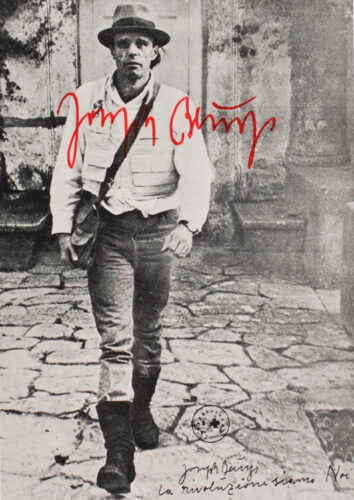
Since then, Beuys’ felt hat and the vest with many pockets have become the uniform of many artists. The art world had been globalized and, with it, the memory of Beuys. In many cases, we find these souvenirs not only on the street or on the Internet, but also in great museums around the world. I will present two examples that make use of Beuys’s model.
Jari Silomäki’s action consisted in the fact that he took thousands of steps in Tiananmen Square in Beijing, following the memorial route of the protesters. His action may be the artistic expression of a supposed Beuys model. The second example is an anonymous underground street advertisement in Budapest, whose creator used his tools to demonstrate the free experiments of artistic expression in the sense of the Beuys model.

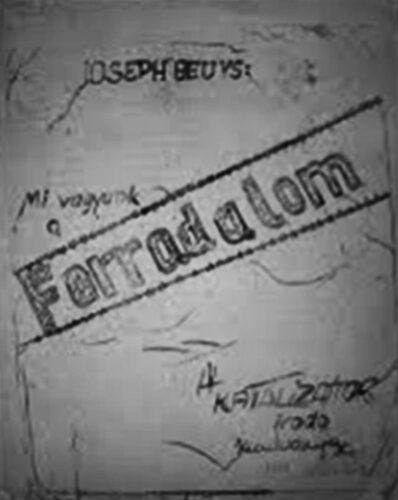
[1] Tibor Várnagy: Introduction in the Hungarian edition, p. 7. In: Lucrezia De Domizio Durini: A felt hat / Joseph Beuys / A narrated life (translated by Miklós Erhardt), Exit, Budapest 2001.
[2] Beuys’ answer to the audience’s question. In: Matthias Bunge: Joseph Beuys. Plasztikai gondolkodás Hírverés egy antropológiai mûvészetfogalomnak, Balkon 2000/10,11
[3] Beuys’ answer to the audience’s question. In: Matthias Bunge: Joseph Beuys. Plasztikai gondolkodás Hírverés egy antropológiai mûvészetfogalomnak, Balkon 2000/10,11
[4] Joseph Beuys in a video interview with Karl Oskar Blase during Documenta 6, 1977
[5] Caroline Tisdall: Joseph Beuys / From a telephone conversation / On fat, honey and all the rest In: Multidézetek, 1980, The contemporary art text collection, The Popular Education Institute Budapest (Népművelési Intézet Budapest), 1980. Selected studies and introductions by László Beke.
[6] Joseph Beuys: Action for planting 7.000 oaks, Documenta VII, Kassel, 1982, online source: https://www.documenta.de/en/retrospective/documenta_7#
[7] Coyote – a wild dog that resembles the wolf, native to North America.
[8] triangulo – percussion instrument; an open triangle made of a thin steel rod that makes a sound when struck with a metal rod
[9] This lamentation of the postmodernist critic is partly justified. This phenomenon is beautifully described by the well-known curator and art critic Nicolas Bourriaud, I quote: “In postmodern discourse, ‘recognition of the other’ often means nothing more than inserting its image into the catalog of primitive and exotic cultures.” “Animal humanism? This perceived ’respect’ for the other results in a reverse colonization that is as polite and seemingly well-intentioned as the earlier one that was brutal and negating. See Bourriaud, Nicolas. 2009. adicaux et radicants. In uő. Radicant. Pour une esthétique de la globalization. Paris: Denoël. Pour une esthétique de la globalization. Paris: Denoël. Hungarian translation: Nicolas Bourriaud: Radikáns* Esthetics of globalization. In: Space Theory Culture, Interdisciplinary spatial theory text collection , p. 149
[10] See Jari Silomäki’s other actions and their photos http://jarisilomaki.com/we-are-the-revolution-after-joseph-beuys/
POSTED BY
Alexandru Antik
Alexandru Antik (1950, Reghin) lives and works in Cluj. His work is focused on an experimental approach, especially in the area of performance, installation and multimedia art. He has been participati...


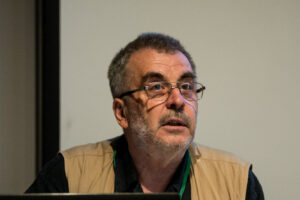
Comments are closed here.